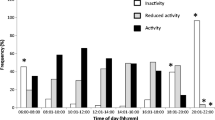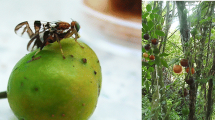Abstract
Sex pheromones produced by females of Rhagoletis conversa Bréthes and Rhagoletis brncici Frías are deposited on the surface of fruits after the eggs are laid. These pheromones repel other females, preventing repeated oviposition on the same fruit. They also attract males, thus assisting mating. Observations were made on wild populations, and cross-species behavioral tests were performed on males. The pheromone released by females was significantly more attractive for males of the same species. The two species showed remarkable differences in mating behavior, in the duration of oviposition, and in the number of circuits made around the fruit after eggs were laid. A morphological analysis of flies collected from their respective host plants indicated great host fidelity and the reproductive isolation of the two species. Possibly, the specific male-arresting effect of this pheromone was important for the sympatric speciation and evolution of these sibling species.
Similar content being viewed by others
References
Aluja M, Prokopy RJ (1992) Host search behavior by Rhagoletis pomonella flies: inter-tree movement patterns in response to wind-borne fruit volatiles under field conditions. Physiol Entomol 17:1–8
Aluja M, Prokopy RJ, Elkinton JS, Laurence F (1989) Nobel approach for tracking and quantifying the movement patterns of insects in three dimensions under seminatural conditions. Environ Entomol 18:1–7
Boller EF (1981) Oviposition-deterring pheromone of the European cherry fruit fly: status of research and potential applications. In: Mitchell ER (ed) Management of insect pests with semiochemicals. Plenum Publishing Corp, New York, pp 457–462
Boller EF, Shoni R, Bush GL (1987) Oviposition deterring pheromone in Rhagoletis cerasi: biological activity of a pure single compound verified in semi-field test. Entomol Exp Appl 45:17–22
Bush GL (1966) The taxonomy, cytology, and evolution of the genus Rhagoletis in North America (Diptera: Tephritidae). Bull Mus Comp Zool 134:431–562
Díaz-Fleischer F, Papaj DR, Prokopy RJ, Norrbom AL, Aluja M (2000) Evolution of fruit fly oviposition behavior. In: Aluja M, Norrbom AL (eds) Fruit flies (Tephritidae): phylogeny and evolution of behavior. CRC Press, Boca Raton, pp 811–841
Foote RH (1981) The genus Rhagoletis Loew South of the United States. United States Department of Agriculture. Tech Bull 1607:75
Frías LD (1986) Biología poblacional de Rhagoletis nova (Schiner) (Díptera :Tephritidae). Rev Chil Entomol 13:75–84
Frías LD (1988) Tiempos y modos de especiación. En: Ibcia Santibañez (ed). Manejo del tiempo en biología y sus ingeniosas maneras de estudiarlo. Facultad de Medicina, Universidad de Chile, Copyrigth, Biblioteca Nacional, pp 145-158
Frías LD (1989) Ecological and reproductive differentiation of two host races of Rhagoletis conversa (Bréthes) (Diptera Tephritidae). Acta Entomol Chilena 15:163–170
Frías LD (1995) Comportamiento de oviposición de Rhagoletis tomatis en tomate (Lycopersicum esculentum) (Díptera: Tephritidae). Acta Entomol Chilena 19:159–162
Frías LD (2001) Genetic and morphological differences of the immature stages of two races of Rhagoletis conversa (Bréthes) (Diptera Tephritidae), geographic distribution and possible sympatric origin of a new species. Rev Chil Hist Nat 74:73–90
Frías LD (2007) Especiación simpátrica y sus implicaciones genéticas y morfológicas en moscas de las fruta En: Hernández-Ortiz V (ed), Moscas de la fruta en Latinoamérica (Díptera: Tephritidae). Diversidad, biología y manejo. SyG Editores, Distrito Federal, México pp 1-26
Frías LD (2014) Modes of sympatric speciation in phytophagous insects of diptera Tephritidae and the importance of epigenetics and behavior imprinting in host fidelity. J Insect Sci Photon 115:179–194
Frías LD, Malavasi A, Morgante JS (1984) Field observations of distribution and activities of Rhagoletis conversa (Díptera Tephritidae) on two host in nature. Ann Entomol Soc Am 77:548–551
Frías LD, Hernández- Ortíz V, Vaccaro NC, Bartolucci A, Salles LA (2006) Comparative morphology of immature stages in some species of the genera Anastrepha, Toxotrypana, Rhagoletis, Bactrocera and Ceratitis (Díptera Tephritidae). In: Freidberg A (ed) Biotaxonomy of Tephritoidea. Isr J Entomol 35-36: pp: 423-457
Frías LD, Selivon D, Hernández-Ortiz V (2008) Taxonomy of immature stages: new morphological characters for Tephritidae larvae identification. In: Sugayama RL, Zucchi RA, Ovruski SM, Sivinski J (eds) Fruit flies of economic importance: from basic to applied knowledge. Proceedings 7th International Symposium on Fruit Flies of Economic Importance. Biofábrica Mosca Med, Salvador, Brazil, pp 29-44
Katsoyannos BI (1975) Oviposition-deterring, male-arresting, fruit-marking pheromone in Rhagoletis cerasi. Environ Entomol 4:801–807
Katsoyannos BI, Boller EF (1976) First field application of oviposition-deterring marking pheromone of European cherry fruit fly. Environ Entomol 5:151–152
Katsoyannos BI, Boller EF (1980) 2nd field application of oviposition-deterring pheromone of the European cherry fruit-fly, Rhagoletis cerasi (Diptera, Tephritidae). J Appl Entomol 89:278–281
Linn C, Feder JL, Nojima S, Danbroski HR, Berlocher SH, Roelofs W (2003) Fruit odor discrimination and sympatric speciation host race formation in Rhagoletis. Proc Natl Acad Sci 100:11490–11493. doi:10.1073/pnas.1635049100
Mumtaz MM, Aliniazee MT (1983) The oviposition-deterring pheromone in the western cherry fruit fly, Rhagoletis indifferens Curran (Dipt., Tephritidae). Biological properties. Z Angew Entomol 96:83–93
Norrbom AL, Carroll LE, Freidberg A (1998) Status of knowledge. In: Thompson FC (ed) Fruit fly expert identification system and systematic information database. North American Dipterists, Society Backhuys Publishers, Leiden, pp 9-47
Prokopy RJ, Bush GL (1972) Mating behavior in Rhagoletis pomonella (Diptera: Tephritidae). III. Male aggregation in response to an arrestant. Can Entomol 104: 275-283. Prokopy RJ, Reissig WH, Moericke V (1976) Marking pheromone deterring repeated oviposition in Rhagoletis flies. Entomol Exp Appl 20: 170-178
Prokopy RJ, Roitberg BD (1984) Resource partitioning. In: Bell WJ, Carde RT (eds) Chemical ecology of insects. Chapman and Hall, London, pp 301–330
Silva MA, Dias Bezerra-Silva GC, Mastrangelo TH (2012) The host marking pheromone application on the management of fruit flies. Braz Arch Biol Technol 55:835–842
Smith JJ, Bush GL (2000) Phylogeny of the subtribe Carpomyina (Trypetinae), emphasizing relationships of the genus Rhagoletis. In: Aluja M, Norrbom AL (eds) Fruit flies (Tephritidae): phylogeny and evolution of behavior. CRC Press, Boca Raton, pp 187–217
Wicker-Thomas C (2007) Pheromonal communication involved in courtship behavior in Diptera. J Insect Physiol 53:1089–1100
Acknowledgments
Thanks to Dr. Raúl Godoy-Herrera for the enriching commentaries on the manuscript, as well as the suggestions of an anonymous reviewer. This research was supported by Project Code: FIBE 07-12, Dirección de Investigación de la Universidad Metropolitana de Ciencias de la Educación (DIUMCE).
Author information
Authors and Affiliations
Corresponding author
Additional information
Edited by Stefano Colazza – Univ of Palermo
Rights and permissions
About this article
Cite this article
Frías-Lasserre, D. Effects of Female fruit-marking Pheromones on Oviposition, Mating, and Male Behavior in the Neotropical Species Rhagoletis conversa Bréthes and Rhagoletis brncici Frías (Diptera: Tephritidae). Neotrop Entomol 44, 560–564 (2015). https://doi.org/10.1007/s13744-015-0326-1
Received:
Accepted:
Published:
Issue Date:
DOI: https://doi.org/10.1007/s13744-015-0326-1




